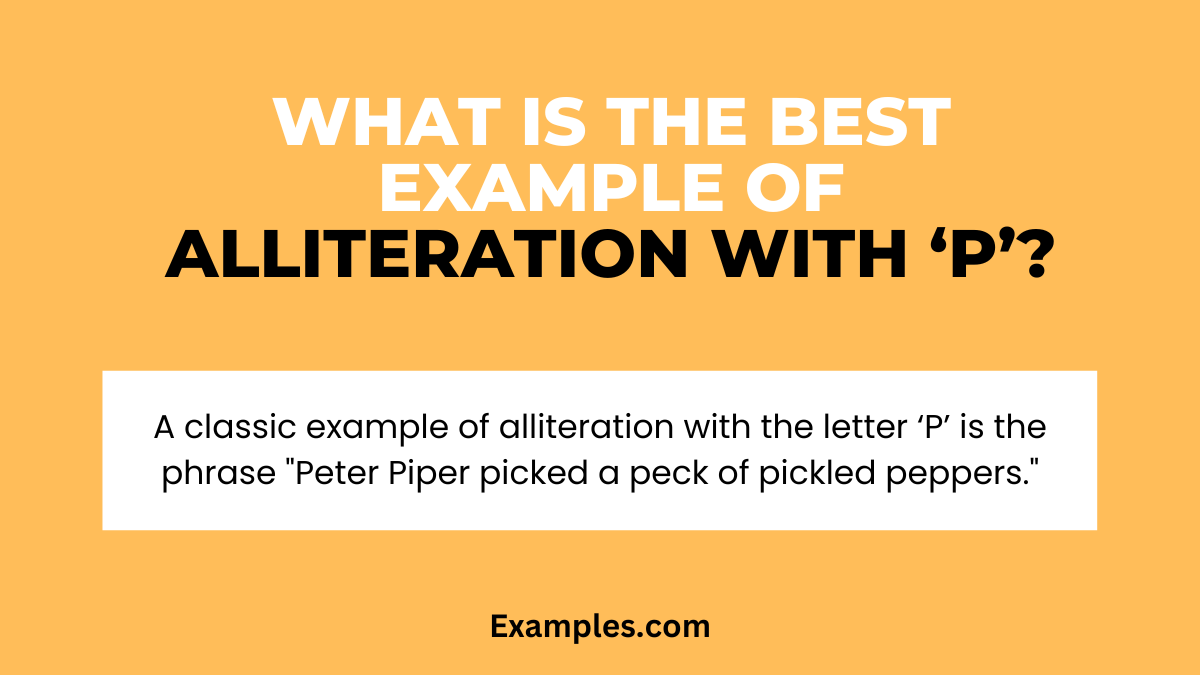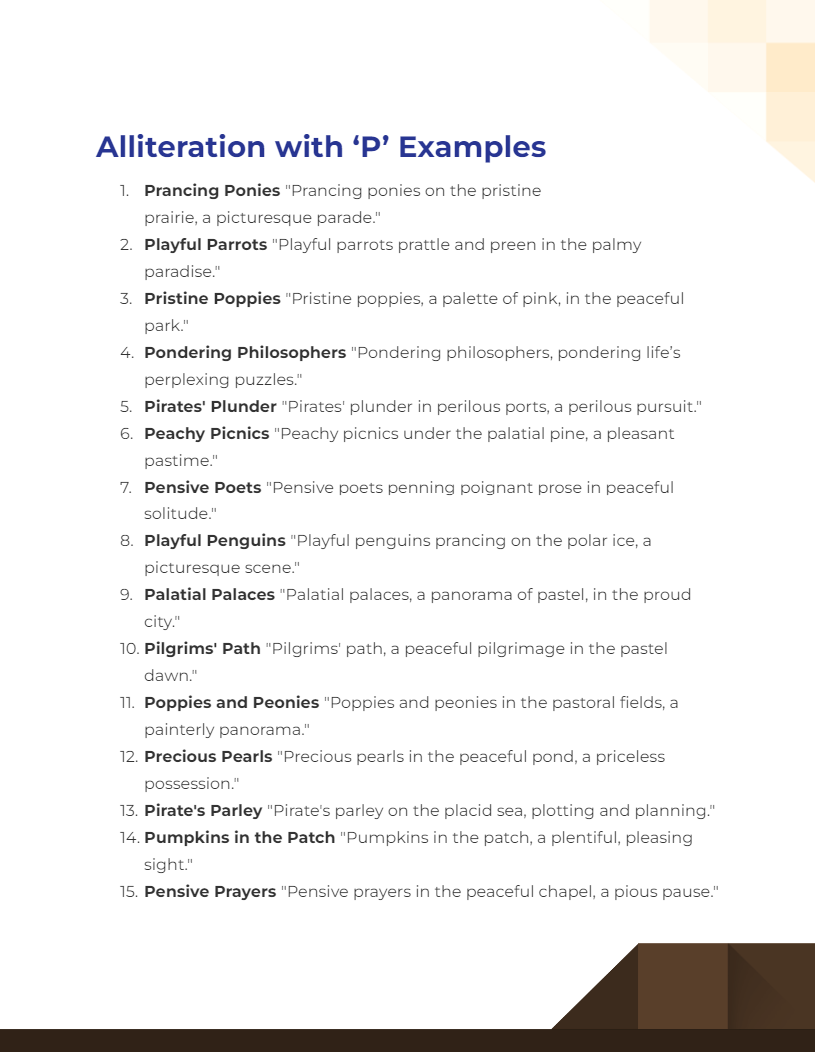19+ Alliteration with P Examples
Alliteration with the letter ‘P’ possesses a particularly powerful and punchy presence in literature and speech. This form of alliteration, which involves the repetition of the ‘P’ sound at the start of closely connected words, adds a playful and sometimes poignant punch to phrases. It’s a technique favored for its ability to create emphasis, evoke emotions, and add a lyrical quality to text. Writers and poets often employ ‘P’ alliteration to paint vivid pictures with their words, making their prose or poetry more engaging and memorable. Whether you’re penning a poem, crafting a creative story, or even developing marketing material, incorporating ‘P’ alliteration can provide a pleasing and persuasive effect.
Download Alliteration with 'P' Examples
Download Alliteration with 'A' to 'Z' Examples
What is the Best Example of Alliteration with ‘P’?

Example: A classic example of alliteration with the letter ‘P’ is the phrase “Peter Piper picked a peck of pickled peppers.”
Meaning: Alliteration is a literary device where consecutive words in a sentence or phrase begin with the same consonant sound. In the example “Peter Piper picked a peck of pickled peppers,” the consonant ‘P’ is repeated at the beginning of several words, creating a playful and melodic sound pattern. This technique is often used in poetry, tongue twisters, and literature to add emphasis, rhythm, and musicality to the text. In this specific example, the easy alliteration repeated ‘P’ sound makes the sentence fun to say and challenging to articulate quickly, making it a classic tongue twister.
20 Alliteration with ‘P’ Examples

Download Alliteration with 'P' Examples in PDF
Alliteration with the letter ‘P’ presents a parade of playful and poetic phrases, pulsating with life and rhythm. The ‘P’ sound, known for its punchy and sometimes plosive quality, offers a plethora of possibilities for both easy and hard alliteration examples. This type of alliteration is particularly effective in alliteration in rhymes, where the repetition of the ‘P’ sound adds a rhythmic and engaging dimension to verses. Here are 20 unique examples of alliteration with ‘P’, each complemented by a rhyme title that captures the essence of the phrase.
- Prancing Ponies “Prancing ponies on the pristine prairie, a picturesque parade.”
- Playful Parrots “Playful parrots prattle and preen in the palmy paradise.”
- Pristine Poppies “Pristine poppies, a palette of pink, in the peaceful park.”
- Pondering Philosophers “Pondering philosophers, pondering life’s perplexing puzzles.”
- Pirates’ Plunder “Pirates’ plunder in perilous ports, a perilous pursuit.”
- Peachy Picnics “Peachy picnics under the palatial pine, a pleasant pastime.”
- Pensive Poets “Pensive poets penning poignant prose in peaceful solitude.”
- Playful Penguins “Playful penguins prancing on the polar ice, a picturesque scene.”
- Palatial Palaces “Palatial palaces, a panorama of pastel, in the proud city.”
- Pilgrims’ Path “Pilgrims’ path, a peaceful pilgrimage in the pastel dawn.”
- Poppies and Peonies “Poppies and peonies in the pastoral fields, a painterly panorama.”
- Precious Pearls “Precious pearls in the peaceful pond, a priceless possession.”
- Pirate’s Parley “Pirate’s parley on the placid sea, plotting and planning.”
- Pumpkins in the Patch “Pumpkins in the patch, a plentiful, pleasing sight.”
- Pensive Prayers “Pensive prayers in the peaceful chapel, a pious pause.”
- Playful Puppies “Playful puppies prancing in the park, a pure delight.”
- Pastoral Paintings “Pastoral paintings, a panorama of peaceful pastures.”
- Pilots’ Prowess “Pilots’ prowess in the pearly skies, a powerful performance.”
- Peaceful Pond “Peaceful pond, a place of pensive, poignant thoughts.”
- Puzzling Paradoxes “Puzzling paradoxes in the philosophers’ profound discussions.”
Alliteration Sentence Examples with ‘P’
Alliteration sentence examples with ‘P’ often portray a playful or poignant tone, utilizing the ‘P’ sound to create rhythm and emphasis. This type of alliteration is used in various literary forms, including alliteration in poems, songs, and movies, adding a distinct texture to the narrative. Here are three examples:
- “Paula’s purple parakeet perched proudly on the pear tree.”
- “Peter’s playful puppies pounced on the plush pillows.”
- “Pamela’s paintings portrayed peaceful pastoral panoramas.”
Alliteration Examples with ‘P’ Words
Alliteration examples using ‘P’ words demonstrate the versatility of this consonant in creating memorable and impactful phrases. Often employed in alliteration in songs, the ‘P’ sound adds a lively element. Here are three examples:
- “Pristine pearls placed precisely on the plush pillow.”
- “Percy’s pizzeria presented a plethora of palatable pies.”
- “The pensive poet pondered the perplexing puzzle.”
Alliteration Examples with ‘P’ Name
Incorporating names that start with ‘P’ in alliteration enhances the personal touch and relatability of phrases, adding character and depth. Here are three examples:
- “Patrick’s pug, Percy, pranced playfully in the park.”
- “Penny’s passion for painting peonies was palpable.”
- “Paul pondered the perplexing problems at the planetarium.”
Alliteration Examples with ‘P’ Sound
The ‘P’ sound in alliteration can create effects ranging from playful and energetic to soft and soothing. These examples show the diverse use of the ‘P’ sound in alliterative structures. Here are three examples:
- “Precocious parrots playfully pecked at the pumpkin patch.”
- “Pale pink petals peacefully fluttered to the path.”
- “The persistent patter of rain painted the pavement.”
Alliteration Poems with ‘P’
An alliteration poem with ‘P’ uses the repetitive ‘P’ sound to create a rhythmic and engaging poetic experience. Alliteration in poems, especially with the ‘P’ sound, adds a unique lyrical quality. Here are three examples:
- “Pale moon, pass by, / Painting paths in the sky.”
- “Pleasant whispers of the pines, / Peaceful are their sleepy signs.”
- “Playful waves on the shore, / Painting patterns evermore.”
Alliteration Beginning with ‘P’
Alliteration beginning with ‘P’ sets a specific tone and rhythm in a phrase, often creating a memorable and impactful auditory experience. Found in various artistic expressions, including alliteration in movies, it adds a distinctive flair. Here are three examples:
- “Peter’s precise piano playing pacified the perturbed crowd.”
- “The painter’s palette presented a plethora of pigments.”
- “Pam’s penchant for pastries was part of her charm.”
How to Write Alliteration with ‘P’?
Writing alliteration with the letter ‘P’ involves the strategic placement of words that start with the ‘P’ sound close together in a phrase or sentence. The ‘P’ sound, known for its punchy and pronounced quality, can add a lively and potent rhythm to your writing. This technique is versatile, used in various contexts including educational settings like alliteration for first grade and in more sophisticated alliteration figurative language compositions. Here’s how to craft effective alliteration with ‘P’:
- Understand the ‘P’ Sound: Familiarize yourself with the ‘P’ sound. It’s a plosive consonant, creating a sharp, pronounced effect that can bring energy to your writing.
- Select a Theme or Concept: Choose a theme or subject. This helps in selecting ‘P’ words that are relevant and coherent with your topic, whether you’re crafting alliteration with answers or for creative expression.
- Brainstorm ‘P’ Words: Compile a list of words that start with ‘P’. Consider different types of words (nouns, verbs, adjectives) to add variety to your alliteration.
- Construct Your Phrase or Sentence: Arrange the ‘P’ words to form a coherent and rhythmic sentence. Aim for a natural flow that highlights the alliterative effect.
- Read Aloud for Rhythm: Alliteration’s effectiveness is often best judged audibly. Read your sentence aloud to ensure it has a pleasing rhythm.
- Revise for Clarity and Impact: Ensure your alliterative phrase is clear and contributes effectively to your overall message or story.
- Apply in Various Contexts: Adapt your use of ‘P’ alliteration to suit the purpose and audience, whether it’s in alliteration figurative language exercises, as part of teaching alliteration for first grade, or in creative writing.
Tips for Using Alliteration with ‘P’
- Use Sparingly: Alliteration should enhance your writing, not overpower it. Use it to emphasize key points or add stylistic flair but in moderation.
- Maintain Clarity: Your primary goal is to convey a message clearly. Alliteration should complement, not complicate, your narrative.
- Vary Word Length and Complexity: Mix short and long ‘P’ words, as well as simple and complex words, for a more dynamic textual rhythm. This is especially important in alliteration for first grade, where simpler language is necessary.
- Consider the Mood: The ‘P’ sound can be energetic and playful or sharp and poignant. Use it in contexts where this mood is desired.
- Read and Revise: Reading your work aloud helps you assess the rhythm and flow. Adjust as needed to ensure the alliteration enhances the text.
- Appropriate for Audience: Tailor your alliteration to your audience. For example, alliteration for first grade should be simpler and more playful than alliteration for adults.
- Explore Different Forms: Try ‘P’ alliteration in various forms of writing, from poetry and stories to advertising and academic work, to understand its effect.
Remember, the key to effective alliteration with ‘P’ is balancing creativity with readability, ensuring that the alliterative phrases enhance rather than detract from your writing.
What are the Alliteration with ‘P’ for Students?
Alliteration with ‘P’ for students is a valuable tool in education, helping to enhance language skills, including vocabulary expansion, phonetic awareness, and understanding of literary devices. For students, ‘P’ alliterations can range from simple for younger learners to more complex for older students, making them suitable for various educational levels. Here are some examples:
- “Peter’s pet parrot preened its pristine plumage proudly.”
- “Paula’s project on planetary physics was praised by professors.”
- “Penny pondered the perplexing problem posed by the puzzle.”
These alliterations can be used to teach alliteration for students, encouraging them to explore language in a creative and engaging way.
What are the Alliteration with ‘P’ for Kids?
Alliteration with ‘P’ for kids typically involves simple, playful, and engaging phrases that are easy to remember and recite. These alliterations are great for language development, helping kids with phonetics and making learning enjoyable. Here are three examples:
- “Peter Piper picked a peck of pickled peppers.”
- “Pamela’s pink pig pranced in the puddle playfully.”
- “Paul’s playful puppy pulled on the purple pant leg.”
These alliteration examples are specifically tailored for alliteration for kids, focusing on simplicity and fun.
What is the Effect of ‘P’ Letter in Alliteration?
The effect of the ‘P’ letter in alliteration is to create a pronounced, punchy sound that can add energy and emphasis to language. The ‘P’ sound is a plosive consonant, producing a sharp, striking effect that can make phrases more memorable and impactful. In alliteration literature, ‘P’ alliteration is often used to draw attention to specific phrases, set a particular mood, or add a rhythmic quality to the text. Its versatility makes it suitable for all audiences, from alliteration for kids to more sophisticated literary works for adults. The ‘P’ sound is significant in both alliteration and assonance, contributing to the overall sonic appeal of a piece.
What is the Alliteration ‘P’ Type of?
Alliteration with the letter ‘P’ is a type of consonantal alliteration, where the consonant sound at the beginning of adjacent or closely connected words is repeated. It’s a common and effective literary device used in various forms of writing. The ‘P’ type of alliteration can create different effects, from lively and playful to more forceful and prominent, depending on the context and the words chosen. This form of alliteration is seen in a wide range of contexts, from educational materials like great alliteration examples for students to more complex literary compositions for adults. It is often used in conjunction with alliteration and assonance exercises to explore the sonic qualities of language. The ‘P’ type of alliteration is appreciated for its ability to add a rhythmic quality to writing, enhancing its impact and memorability.


